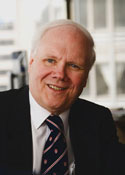Continuing Education: the Centre that never sleeps
Continuing Education: the Centre that never sleeps McGill University
User Tools (skip):
Continuing Education: the Centre that never sleeps
For most McGillians, May means gearing down. Classes are long done, papers handed in and corrected and the remnants of exam anxiety just a distant flutter in student stomachs. Aside from the buzz of Convocation preparations, McGill is undergoing its annual end-of-year transformation from hive of activity to an oasis of almost bucolic beauty.
Unless, of course, you happen to be part of the Centre for Continuing Education, which just keeps chugging along.
McGill's unofficial "centre that never sleeps," the Centre has always been one of the university's best-kept secrets, mostly because it operates primarily at night, when the majority of McGillians have headed home. During the summer, it caters to some 3,000 students in a variety of professional workshops and courses ranging from translation to project management.

Glenn Cartwright, interim dean of the Centre for Continuing Education, believes that continuing higher education is a burgeoning field.
Claudio Calligaris
Glenn Cartwright, interim dean of the Centre for Continuing Education, says that scheduling isn't the only things that set Continuing Education apart from the rest of McGill. "On average, our students are older than the rest of the student body—around 33 years old," he said. "Many have families and fulltime jobs, so, because it's tough to juggle both of those and school, most come to school at night when we take over the classrooms."
That difference has sometimes led to misconceptions about the Centre and its students. "I think part of the stigma comes from the fact that we don't hand out our own degrees," said Cartwright. However, 25 of its 41 diplomas and certificates are at the graduate level. "Continuing higher education is really our field," said Cartwright.
The classrooms are also rich with "real life" experience. Aside from a student body that is generally already in the workforce, the Centre boasts some 375 lecturers, many who work as professionals during the day only to impart that practical knowledge in classrooms at night. "We are the first-stop for professional upgrading," says Cartwright.
No unit under the Continuing Education umbrella has more life experience than the McGill Institute for Learning in Retirement (MILR). Comprised of more than 900 seniors, including some well into their 90s, MILR requires no educational prerequisites and has no exams or grades. Instead, the study groups—which range from philosophy and art appreciation to current events and creative writing—are self-directed and emphasize peer learning. Apparently, education goes on and on.

